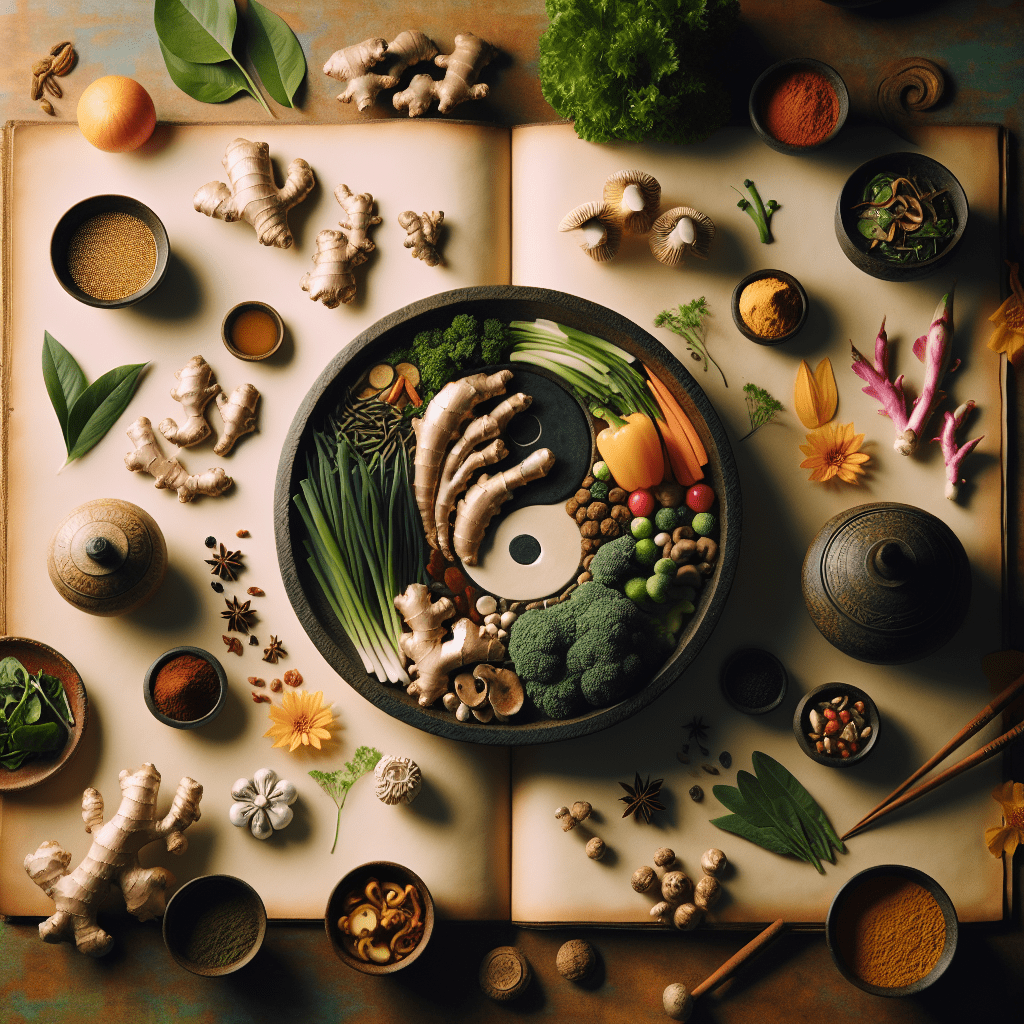Have you ever wondered why some foods leave you feeling energized while others seem to drain your vitality? The answer may lie in a 2,000-year-old approach to nutrition that Eastern medicine has been quietly preserving all along. Holistic foods—nature’s gift to our wellbeing—aren’t just about calories and nutrients, but about energy, balance, and harmony with our bodies and the world around us.

Nature’s pharmacy: A colorful array of holistic foods rich in healing properties.
Unlike the Western approach that often reduces food to proteins, carbs, and fats, Eastern medicine views food as medicine—a philosophy that forms the foundation of holistic nutritional wellness. This ancient wisdom sees the body as an interconnected system where what we eat directly influences our physical, mental, and emotional health.
At its core, Eastern nutrition operates on a simple yet profound principle: food is not just fuel but a powerful tool for healing and maintaining balance. This perspective aligns beautifully with what many health-conscious individuals are discovering today—that true wellness comes from a holistic approach to nourishment.
The Energy of What We Eat: Understanding Food Properties
“In Eastern medicine, food is never just food—it’s a direct pathway to wellness and vitality.”
In Eastern medicine, particularly Traditional Chinese Medicine (TCM), foods are not just categorized by their nutritional content but by their energetic properties. This might sound mystical to Western ears, but it’s actually quite logical when you understand the principles.
Foods can be damp natured, cold natured, or hot natured. These aren’t temperatures in the literal sense, but rather how they affect our body’s internal environment. For example, cucumber has a cooling energy that helps reduce internal heat and inflammation, while ginger generates warmth and stimulates circulation.
“When qi is sufficient, we have energy to fight infections, transform the food we eat into accessible nutrients, and move the body’s various tracts forward,” explains a practitioner of TCM. This concept of qi—or life energy—is central to understanding how holistic foods work within our bodies.
Consider how you feel after eating a spicy curry versus a fresh salad. The warming sensation from chili peppers isn’t just in your mouth—it’s creating a warming effect throughout your system. Similarly, watermelon’s refreshing quality isn’t just about its water content, but its ability to cool internal heat.
Modern wellness trends are increasingly embracing these concepts, with many nutritionists now recommending seasonal eating patterns that align with what Eastern medicine has taught for centuries. During winter months, warming foods like root vegetables and hearty soups help strengthen our immunity, while cooling fruits and leafy greens balance the external heat of summer.
The Five Flavors: A Map to Organ Health
One of the most fascinating aspects of Eastern nutritional theory is the classification of foods by their five tastes: sweet, sour, bitter, pungent (spicy), and salty. Each flavor corresponds to specific organ systems and has distinct effects on our bodily functions, a cornerstone of Five Elements Theory.
Sweet foods like rice, squash, and fruits nourish the spleen and stomach, which are central to digestion in Eastern medicine. The earth element, represented by these organs, thrives on sweet flavors provided in moderation. This doesn’t mean gorging on candy—rather, it refers to the natural sweetness found in whole grains and vegetables.
Sour flavors like those found in lemons and fermented foods support liver function. The liver, associated with the wood element, benefits tremendously from these foods, which help detoxify the body and promote the smooth flow of qi.
Bitter foods such as dark leafy greens stimulate the heart and small intestine, helping to clear heat and dry dampness within the body. “The bitter flavor also has a draining and drying effect on the body,” notes a TCM resource, explaining why these foods can be particularly beneficial for conditions involving excess moisture or congestion.
Pungent herbs and spices like ginger, garlic, and spring onions serve the lungs and large intestine. They stimulate circulation, generate warmth, and help expel cold from the body—crucial for respiratory health and immunity.
Finally, salty flavors nourish the kidneys and bladder, supporting our foundational energy and reproductive health. Sea vegetables and miso provide this flavor in a balanced way that supports rather than depletes kidney function.
This personalized approach to nutrition based on individual constitution and needs is precisely what modern holistic health platforms like EASTCHI AI are bringing to contemporary wellness seekers. By understanding your dominant elements and current imbalances, you can select foods that specifically support your body’s unique requirements.
The Dance of Yin and Yang: Cooling and Warming Foods
“The balance of yin and yang in our diet mirrors the balance we seek in our lives—harmony begins on our plate.”
Perhaps the most fundamental concept in Eastern nutritional theory is the balance of yin and yang—complementary forces that must remain in harmony for optimal health. In dietary terms, this translates to a balance between cooling (yin) and warming (yang) foods.
Yang foods generate heat and energy, activating metabolic processes and stimulating circulation. These include beef, lamb, chicken, ginger, cinnamon, and most spices. They’re particularly beneficial during colder months or for people with naturally cold constitutions who may experience poor circulation or fatigue.
“In Traditional Chinese Medicine, all foods fall along a spectrum of warming, neutral, or cooling. These properties affect the balance of yin and yang in the body,” explains a nutritional expert versed in Eastern principles. This isn’t about food temperature but about the food’s effect on your body’s energy.
Yin foods, by contrast, cool and calm the system. Cucumber, watermelon, lettuce, tofu, and most fruits have this cooling property. They’re perfect for summer months or for balancing conditions characterized by excess heat like inflammation, skin eruptions, or irritability.
A balanced diet includes both yin and yang foods, with proportions shifting seasonally. As one holistic nutritionist puts it, “You can balance yin and yang by listening to your body, eating seasonally (more yin foods in summer, more yang in winter), and combining foods in your meals.” This approach aligns with what research on seasonal food benefits has consistently shown.
This approach is gaining traction in contemporary dietary practices as people notice how certain foods either aggravate or alleviate their symptoms. Someone with inflammatory conditions might find relief by incorporating more cooling foods, while a person with chronic fatigue might benefit from more warming choices.
The beauty of this system lies in its adaptability and personalization—exactly what modern wellness seekers desire and what platforms like EASTCHI AI deliver through customized nutritional guidance based on these time-tested principles.
Nature’s Pharmacy: Therapeutic Holistic Foods
Warming Foods
- Ginger
- Cinnamon
- Lamb
- Garlic
Cooling Foods
- Cucumber
- Watermelon
- Mint
- Leafy greens
Eastern medicine has identified numerous foods with specific therapeutic effects that go far beyond basic nutrition. These holistic foods can be strategically incorporated into daily diets to address particular health concerns or enhance overall vitality.
Take ginger, for instance. This humble root is warming and energizing, strengthening the spleen and helping to protect against pathogenic invasions. It’s no coincidence that ginger tea is a go-to remedy for colds and digestive complaints across many cultures.
Black beans, now recognized for their probiotic properties, have been valued in Eastern medicine for centuries. Research from reputable health institutions confirms they “improve gut health and glucose metabolism through bioactive peptides,” validating what Eastern practitioners have long understood about their benefits for kidney function and blood building.
Mushrooms like shiitake and reishi hold a special place in Eastern nutrition as powerful immune modulators. Rich in beta-glucans and other compounds that support immunity, these fungi have been used for millennia to strengthen resistance to disease and promote longevity.
“Eat Well, Feel Better. These foods aren’t trends—they’re timeless tools in Chinese Medicine. When used with intention, they support digestion, energy, immunity,” notes a resource on holistic foods, highlighting their enduring relevance.
For those looking to enhance mental clarity and cognitive function, foods like walnuts (which resemble the brain in appearance), goji berries, and green tea have been used in Eastern traditions to nourish brain function and preserve memory.
Digestive health—a cornerstone of overall wellness in Eastern medicine—can be supported with fermented foods like kimchi and miso, along with warming spices like cardamom and fennel that gently stimulate digestive fire without creating excess heat.
For women’s health, black sesame seeds, dates, and longan fruit are traditionally used to nourish blood and support reproductive function—a holistic approach to hormonal balance that many are rediscovering as alternatives to conventional treatments.
The Modern Revival of Ancient Wisdom
“Ancient wisdom meets modern science in today’s holistic approach to nutrition.”
What Eastern medicine has known for thousands of years is finally gaining scientific validation and mainstream acceptance. Holistic foods aren’t just a trend; they represent a return to fundamental principles of health that human bodies have evolved with over millennia.
The beauty of this approach is its accessibility. You don’t need exotic ingredients or complicated recipes to begin incorporating these principles into your daily life. Simple adjustments like adding warming spices to your morning oatmeal in winter, enjoying cooling cucumber and mint water in summer, or selecting foods based on your constitution can make a significant difference in how you feel.
Technology is now making this ancient wisdom more accessible than ever. EASTCHI AI, for instance, combines the time-tested principles of Eastern nutrition with cutting-edge artificial intelligence to create truly personalized dietary recommendations based on your unique constitution, current imbalances, and wellness goals.
By analyzing your constitutional type through Five Element Theory and considering seasonal influences, such platforms can recommend specific holistic foods that will best support your individual journey toward balance. This represents the perfect marriage of ancient wisdom and modern technology—making Eastern nutritional principles practical for contemporary lifestyles.
The shift toward viewing food as medicine rather than merely fuel represents a profound change in how we approach wellness. It reminds us that nature provides exactly what our bodies need when we learn to listen and choose wisely.
As you explore the world of holistic foods guided by Eastern medicine principles, you may discover that the secret to modern wellness isn’t found in the latest supplement or diet trend, but in ancient wisdom that has been hiding in plain sight all along. Your journey toward balanced wellness might just begin with your next meal—chosen not just for its taste or convenience, but for its ability to nourish your unique constitution and bring your body into harmony.
Whether you’re seeking to boost immunity, improve digestion, enhance energy levels, or simply feel more balanced, the ancient secrets of holistic foods offer a path forward that’s both profoundly traditional and remarkably relevant to our modern lives.



